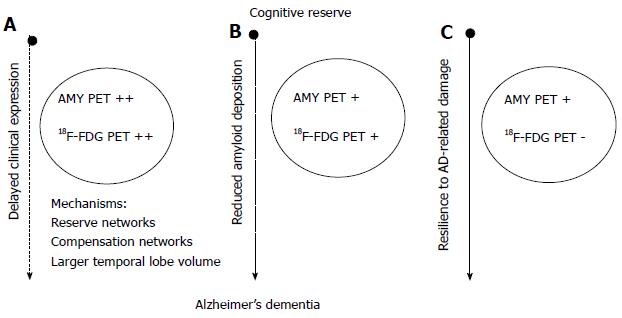Copyright
©The Author(s) 2015.
World J Radiol. Dec 28, 2015; 7(12): 475-483
Published online Dec 28, 2015. doi: 10.4329/wjr.v7.i12.475
Published online Dec 28, 2015. doi: 10.4329/wjr.v7.i12.475
Figure 1 Schematic representation of the possible mechanisms mediating the effect of cognitive reserve on the onset of Alzheimer’s dementia and corresponding expected results on 18F-FDG and amyloid positron emission tomography.
According to hypothesis (A) cognitive reserve (CR) would simply delay the clinical expression of the disease. In fact despite amyloid positron emission tomography (PET) and FDG PET marked positivity patients are able to delay symptoms thanks to compensative functional networks and/or structural features such as larger temporal lobe volume[14,51]. Hypothesis (B) admits an opposite scenario in which, CR would prevent/delay amyloid deposition and Alzheimer’s dementia (AD) pathology and thus neuronal damage and dementia onset[17]. Finally hypothesis (C) could coexist with either of the first two and would explain the effect of CR as a sort of brain resilience despite AD pathology thus allowing a relatively preserved 18F-FDG PET scan for a longer period of time[59]. Amy-PET: Amyloid PET; ++: Markedly positive scan; +: Positive scan; -: Negative/relatively preserved scan.
- Citation: Bauckneht M, Picco A, Nobili F, Morbelli S. Amyloid positron emission tomography and cognitive reserve. World J Radiol 2015; 7(12): 475-483
- URL: https://www.wjgnet.com/1949-8470/full/v7/i12/475.htm
- DOI: https://dx.doi.org/10.4329/wjr.v7.i12.475









